Posted by: Northwest Eye in General on June 15, 2025
Overview
This article gently explores the key differences between PRK and LASIK eye surgeries, focusing on their unique techniques, recovery times, candidacy requirements, risks, costs, and long-term outcomes. We understand that choosing the right procedure can be daunting, and it’s natural to have concerns.
While LASIK typically offers quicker recovery and is often preferred for its rapid visual improvement, PRK may be a more suitable choice for individuals with thinner corneas or those who lead active lifestyles. This is due to PRK’s lower risk of flap-related complications.
Ultimately, the decision between these two options depends largely on your personal circumstances and preferences. We are here to help you through this process, ensuring you feel supported and informed every step of the way.
Introduction
When it comes to vision correction, we understand that the choice between PRK and LASIK can feel daunting. Both procedures promise remarkable results, yet they differ significantly in their techniques and recovery experiences. Understanding these differences is crucial for individuals seeking optimal outcomes tailored to their unique eye health and lifestyle needs.
It’s common to feel overwhelmed with so much information available. How can one navigate the complexities of these surgical options and determine which is best suited for them? This article delves into the essential distinctions between PRK and LASIK, providing insights into their effectiveness, recovery times, candidacy requirements, and more. We are here to help you through this process, guiding you toward making an informed decision about your vision correction journey.
Northwest Eye: Expert LASIK Procedures for Vision Correction
At Northwest Eye, we understand that considering vision correction can be a significant decision. Our clinic is renowned for its outstanding procedures, utilizing advanced technology and methods to help you achieve the best possible outcomes. We prioritize your comfort and knowledge by providing comprehensive consultations that address the eye surgery process, expected results, and vital post-operative care.
With our advanced technology, including wavefront-guided and topography-guided procedures, we guarantee accurate and efficient treatments tailored to your personal requirements. It’s common to feel uncertain about what to expect, but our patient testimonials speak volumes. An impressive 98% of vision correction patients report an enhanced quality of life and a decreased reliance on corrective lenses.
As one specialist notes, ‘When used by a skilled and experienced surgeon, the laser is precise and safe, able to remove a single cell without affecting other cells.’ This dedication to excellence, combined with the latest developments in vision correction technology, establishes Northwest Eye as a reliable option for individuals seeking transformative sight improvement. We are here to help you through this process, ensuring you feel supported every step of the way.
Surgical Techniques: PRK vs LASIK Explained
We understand that considering laser eye surgery can be both exciting and overwhelming. When comparing PRK vs LASIK, both are advanced laser eye surgery procedures designed to correct refractive errors, yet they employ distinct techniques. When comparing PRK vs LASIK, it’s important to note that LASIK involves creating a thin flap in the cornea for precise reshaping of the underlying tissue, leading to quick visual improvement—often within hours—while PRK entails the complete removal of the cornea’s outer layer, which regenerates naturally over several days.
PRK surgery typically takes about 15 minutes for both eyes. It’s common to experience sore or scratchy eyes for a few days afterward, along with halos around lights at night. Although the comparison of PRK vs LASIK techniques may lead to a longer recovery period—often taking 1 to 4 weeks for optimal vision—it can be particularly beneficial for individuals with thinner corneas or those engaged in contact sports, as it eliminates the risk of flap-related complications. For those with active lifestyles or professions that risk flap dislocation, the choice between PRK vs LASIK is often recommended, with PRK being the preferred option.
Both procedures have demonstrated high effectiveness, with approximately 90% of patients achieving 20/20 vision or better post-surgery. The cost of laser eye surgery typically hovers around $2,200 for each eye, while PRK might be several hundred dollars cheaper. We encourage you to discuss your options with an ophthalmologist, who can assess your corneal thickness, lifestyle, and individual eye health requirements.
Recent studies indicate that the safety of PRK vs LASIK techniques is comparable, but the decision ultimately hinges on your unique circumstances and preferences. Remember, we are here to help you through this process. Additionally, resources like the Eye Condition Library at Northwest Eye can empower you to understand your condition and treatment options better.
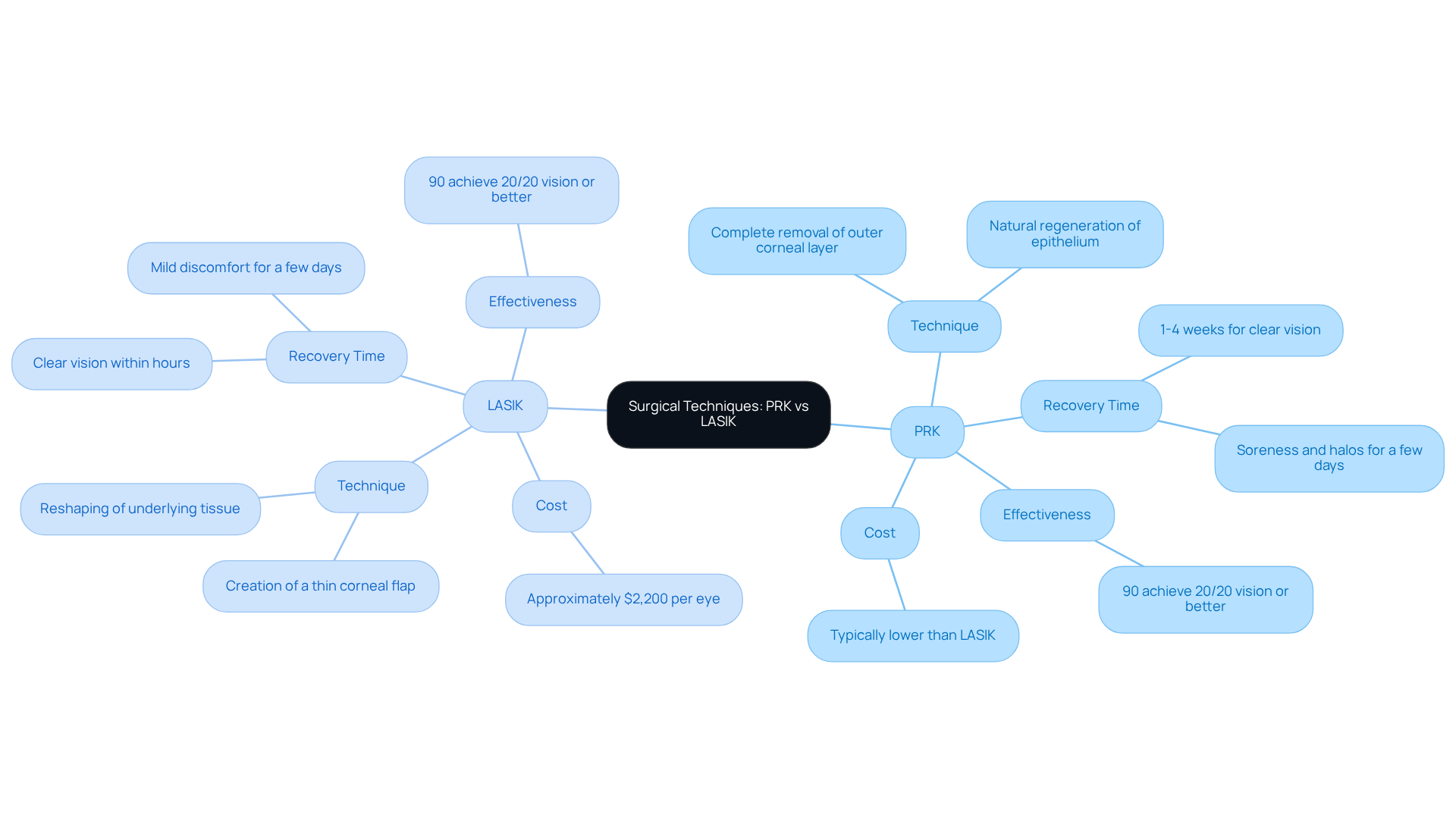
Recovery Times: How PRK and LASIK Differ
We understand that considering the recovery durations for PRK vs LASIK can raise concerns about returning to your regular activities. Generally, laser eye surgery allows individuals to resume their everyday routines within 24 to 48 hours, with many experiencing clear sight almost immediately. In contrast, when discussing PRK vs LASIK, PRK necessitates a longer recovery period, often taking 4 to 7 days for the initial healing process, as the outer layer of the cornea must regenerate.
It’s common to feel anxious about the recovery timeline. Most PRK patients report gradual vision improvement over several weeks, with 9 out of 10 achieving 20/40 vision or better within six months. This extended recovery can involve moderate discomfort, similar to a mild sunburn, particularly during days 2 to 4 post-surgery. However, this discomfort is manageable with prescribed pain relief.
Patient testimonials frequently highlight the significance of understanding these timelines to prepare adequately for your recovery journey. Surgeons emphasize that while laser eye surgery offers quicker outcomes, in the discussion of PRK vs LASIK, PRK may be more suitable for individuals with thinner corneas or those engaged in physically demanding activities, as it eliminates the risk of flap dislodgment associated with the first method. Additionally, PRK may be a few hundred dollars more affordable than the alternative procedure.
Overall, both procedures boast high satisfaction rates. It’s important to consider your individual recovery preferences and lifestyle needs when making a choice. We are here to help you through this process, ensuring you feel supported every step of the way.
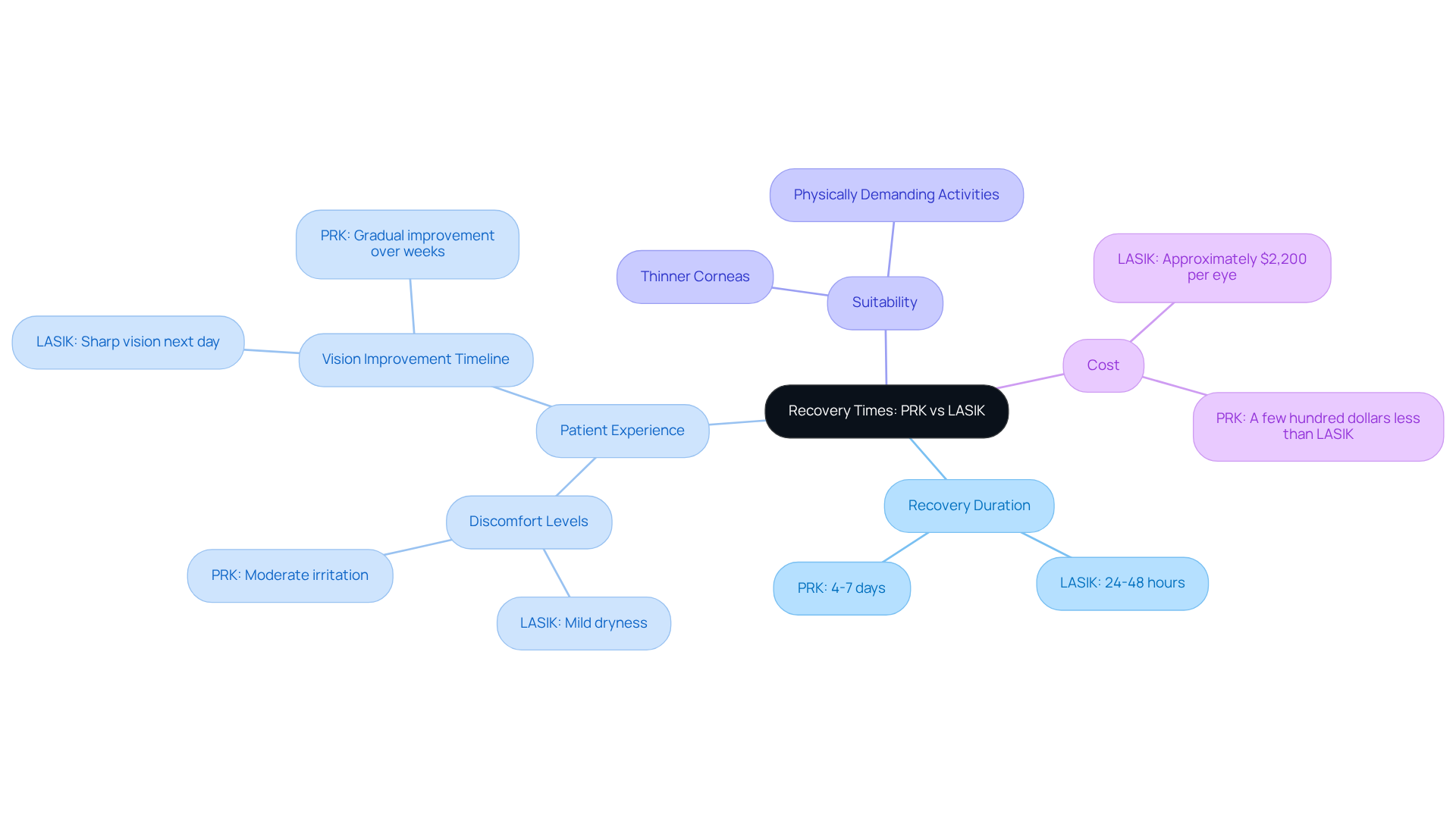
Candidacy: Who Qualifies for PRK vs LASIK?
Assessing eligibility for eye surgery or PRK is crucial, as we understand that not everyone meets the criteria for these procedures. This eye surgery is typically recommended for individuals with sufficient corneal thickness—generally at least 480 microns—and stable vision prescriptions. On the other hand, when considering PRK vs LASIK, PRK may be a better choice for those with thinner corneas, irregular corneal shapes, or specific eye conditions that could make the other procedure less feasible. For example, individuals who participate in contact sports or have a history of dry eyes may find PRK more suitable due to its safety profile in high-risk scenarios.
A comprehensive evaluation by an eye care professional at Northwest Eye is essential to assess these factors. This evaluation includes measuring corneal thickness and examining overall eye health, which are critical in determining the best surgical option for you. Recent advancements in laser technology have broadened eligibility for the procedure, allowing more individuals to consider this option. However, it remains vital to ensure that candidates meet the necessary criteria.
Real-life examples can shed light on this distinction: individuals with stable prescriptions and adequate corneal thickness often qualify for laser surgery, while those with thinner corneas or irregularities may be directed towards PRK vs LASIK. Ultimately, the decision regarding PRK vs LASIK should be based on a personalized evaluation, ensuring that each patient receives the most suitable care tailored to their unique requirements. We are here to help you through this process, providing the support and guidance you need.
Risks and Complications: Evaluating PRK and LASIK
Both PRK and other refractive surgeries come with inherent risks that can understandably cause concern. These include dry eyes, glare, halos, and potential under or over-adjustment of sight. It’s common to feel apprehensive about symptoms like halos—bright circles surrounding light sources—and glare, which may interfere with vision, especially in low-light conditions. Importantly, this procedure accounts for 96% of refractive surgeries performed in the United States and boasts a complication rate of around 0.3%, one of the lowest for elective operations.
We understand that the thought of laser eye surgery may raise worries about flap-related complications, as it involves creating a corneal flap. However, most complications can be easily corrected or addressed. In contrast, when considering PRK vs LASIK, PRK does not involve a flap, which can lead to longer recovery times and increased discomfort during the healing process. Recent studies indicate that both PRK vs LASIK procedures are generally safe, but the choice between them should be guided by your individual circumstances and preferences.
We encourage you to engage in thorough discussions with your surgeon to fully understand these risks, including the potential for halos and glare, and how they may specifically affect you. This dialogue is essential for ensuring an informed decision-making process. Additionally, considering personalized options for enhancing your vision can further empower you in your choices. Remember, we are here to help you through this process.
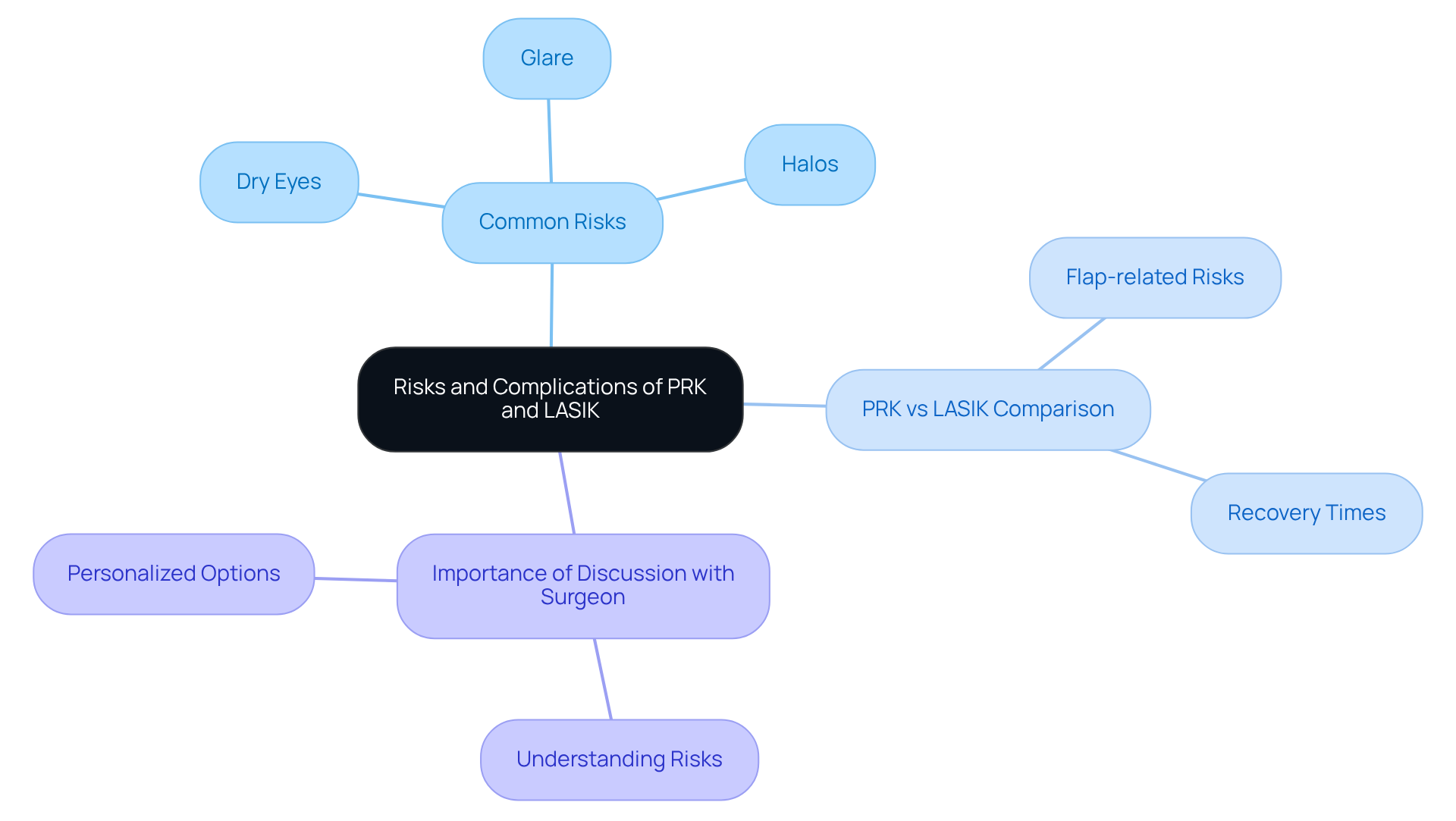
Cost Comparison: PRK vs LASIK
The expenses associated with PRK vs LASIK and other corrective eye procedures can vary based on several factors, including the technology used and the surgeon’s expertise. We understand that financial considerations can be daunting, especially when seeking advanced care. Typically, these procedures are priced higher due to the advanced technology and shorter recovery times they offer. For instance, the average cost of laser eye surgery in the U.S. ranges from $1,500 to $4,000 per eye, and when considering PRK vs LASIK, PRK is often a bit more affordable, averaging around $2,300 per eye.
To enhance accessibility, many clinics, including Northwest Eye, provide flexible financing options designed to help you manage your expenses effectively. These options include:
- 0% interest financing for up to 24 months through CareCredit
- Low-interest financing for up to 60 months
- Payments as low as $100 per month
It’s common to feel overwhelmed by these choices, but rest assured, you can submit a credit request online and receive an answer almost immediately, all without impacting your credit report.
Additionally, utilizing Flexible Spending Accounts (FSA) or Health Savings Accounts (HSA) can further assist you in covering costs. Many insurance companies also offer unique discounts for laser eye surgery to their members, making this journey a little easier. When considering PRK vs LASIK, it’s crucial to weigh both the initial expenses and the long-term benefits, such as the potential savings from not needing glasses or contact lenses.
Notably, Northwest Eye offers a variety of financing programs and payment plans to make the cost of care manageable. We are here to help you through this process, ensuring you feel supported every step of the way.

Effectiveness: Comparing Outcomes of PRK and LASIK
We understand that considering laser eye surgery can be a significant decision. When comparing PRK vs LASIK, both procedures boast remarkable success rates, with around 90% of individuals achieving 20/20 clarity or better. It’s common to feel uncertain about recovery; while laser eye surgery typically offers quicker visual recovery, many individuals notice enhancements within just a few days, but in the comparison of PRK vs LASIK, PRK may require a longer stabilization phase, often taking several weeks.
However, it’s reassuring to know that research indicates the long-term results for PRK vs LASIK procedures are remarkably similar. This makes either option a strong choice, tailored to your individual needs and corneal conditions. In fact, studies show that approximately 95% of PRK recipients achieve 20/40 vision or better, with about 70% reaching 20/20 vision or beyond. This reinforces the efficacy of PRK vs LASIK, particularly for those who may not qualify for the LASIK procedure due to thinner corneas.
As technology progresses, both methods continue to demonstrate high satisfaction rates among individuals, with laser eye surgery reaching a satisfaction rate of up to 99%. We are here to help you through this process, ensuring you feel supported every step of the way.
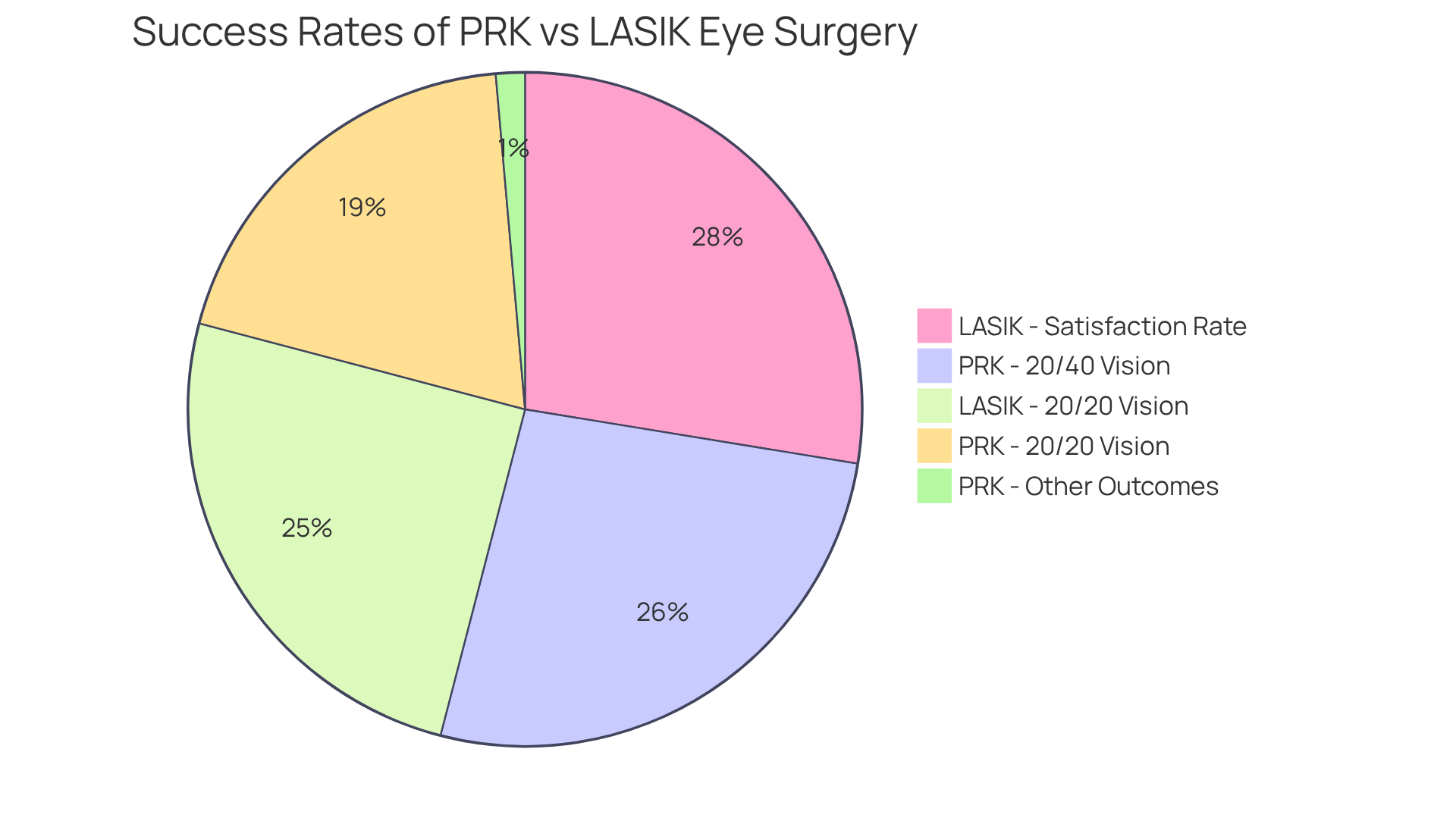
Patient Experiences: Insights on PRK and LASIK
Patients often share varied experiences when discussing PRK vs LASIK, reflecting the unique aspects of each procedure. We understand that each individual’s journey is different. Many individuals undergoing the procedure describe a rapid and nearly painless experience, frequently observing instant enhancements in their sight. For instance, Cody S., a young real estate agent, expressed his gratitude after LASIK, stating he can now see better than ever without the hassle of contacts or glasses, which had been a source of frustration for him.
In contrast, patients may experience some discomfort during the recovery phase when comparing PRK vs LASIK. However, they often emphasize their long-term satisfaction with the results. It’s reassuring to know that nearly 70 percent of patients achieve 20/20 eyesight after PRK vs LASIK, reinforcing their positive outcomes. Katrina R., who underwent PRK after years of wearing glasses, initially faced challenges but ultimately felt the procedure was worth it for her improved vision.
Additionally, Katelyn H., an optometry student, chose LASIK to eliminate her discomfort with glasses and contacts, further emphasizing the benefits of the procedure. Testimonials from Northwest Eye highlight the clinic’s commitment to care. Many individuals value the comprehensive support offered throughout their surgical journey. This dedication to personalized care and client education ensures that each individual feels informed and confident in their treatment options, contributing to high satisfaction rates across both procedures. We are here to help you through this process.
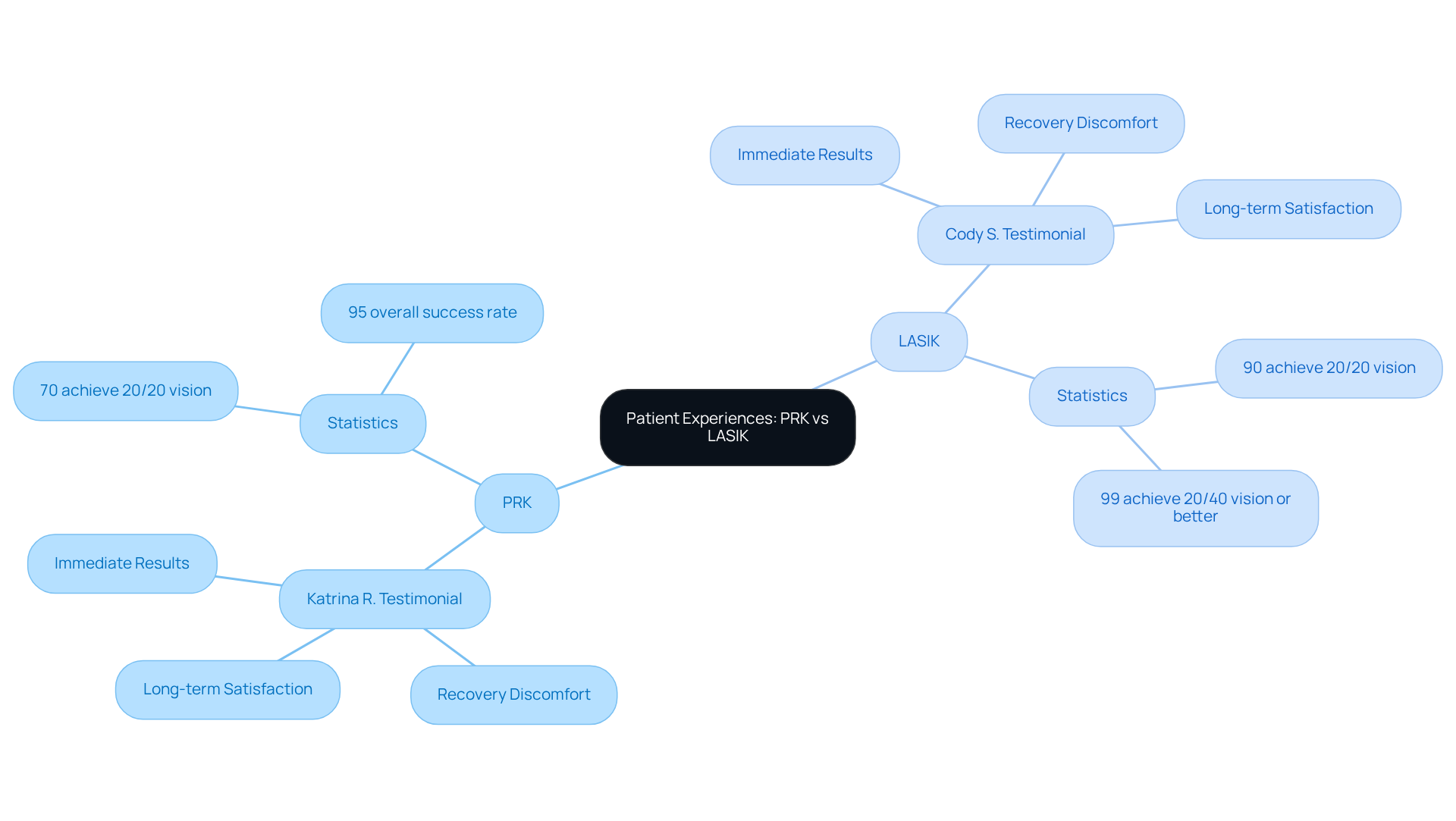
Long-Term Vision Stability: PRK vs LASIK
At Northwest Eye, we understand that considering eye surgery can be a significant decision filled with questions and concerns. When considering PRK vs LASIK, both procedures offer long-term vision stability, with many individuals enjoying clear sight for years after surgery. It’s common to feel anxious about how age, overall eye health, and lifestyle choices may affect your outcomes. Generally, younger individuals and those with healthier eyes tend to experience better results.
When considering PRK vs LASIK, recovery from PRK typically takes three to five days, while LASIK allows individuals to resume regular activities after just one or two days. We want you to know that regular follow-ups with our eye care specialists are essential for tracking any changes in your sight and ensuring your ongoing eye health. This proactive approach enables us to intervene promptly if needed.
Significantly, 91% of LASIK recipients expressed satisfaction with their sight in a five-year follow-up, providing reassurance that many find success with these procedures. However, if you find yourself dissatisfied with your results, it’s important to remember that enhancement surgery is an option.
At Northwest Eye, we also offer innovative treatment alternatives, such as the Light Adjustable Lens (LAL), which allows for customized correction after cataract surgery, and refractive lens exchange. This groundbreaking technology underscores our commitment to providing you with the best solutions for optimal outcomes. We are here to help you through this process, ensuring you feel supported every step of the way.
Key Takeaways: PRK vs LASIK at a Glance
When considering PRK vs LASIK, both procedures are highly effective options for correcting sight, each providing unique benefits suited to individual requirements. We understand that choosing the right procedure can feel overwhelming. The procedure is known for its swift recovery, with numerous individuals noticing enhanced vision within just 24 hours, allowing them to resume regular activities almost immediately. This makes it particularly appealing for those seeking quick outcomes and minimal recovery time.
On the other hand, when considering PRK vs LASIK, PRK might be the preferred option for individuals with certain eye conditions, such as thinner corneas or those engaged in contact sports. It alleviates the risks associated with the corneal flap formed during the procedure. While PRK requires a longer recovery duration—usually three to five days for initial healing—when comparing PRK vs LASIK, it offers comparable long-term results to laser eye surgery, making it a viable choice for many.
Real-world examples illustrate how individuals weigh their options:
- A military member might opt for PRK vs LASIK to avoid flap dislodgment risks during physical activities.
- A busy professional may choose LASIK for its swift recovery.
Expert opinions emphasize that both PRK vs LASIK can effectively correct nearsightedness, farsightedness, and astigmatism. Ultimately, the choice hinges on individual circumstances and lifestyle.
Understanding the key differences in techniques, recovery times, candidacy requirements, risks, costs, and long-term outcomes is crucial for making an informed decision regarding PRK vs LASIK. We are here to help you through this process. Consulting with the experienced team at Northwest Eye ensures personalized guidance tailored to your unique needs, enhancing the likelihood of achieving optimal vision correction. Additionally, Northwest Eye offers a variety of financing programs and payment plans to make the cost of care easy and manageable, ensuring that you can access the eye care services you need without financial strain.
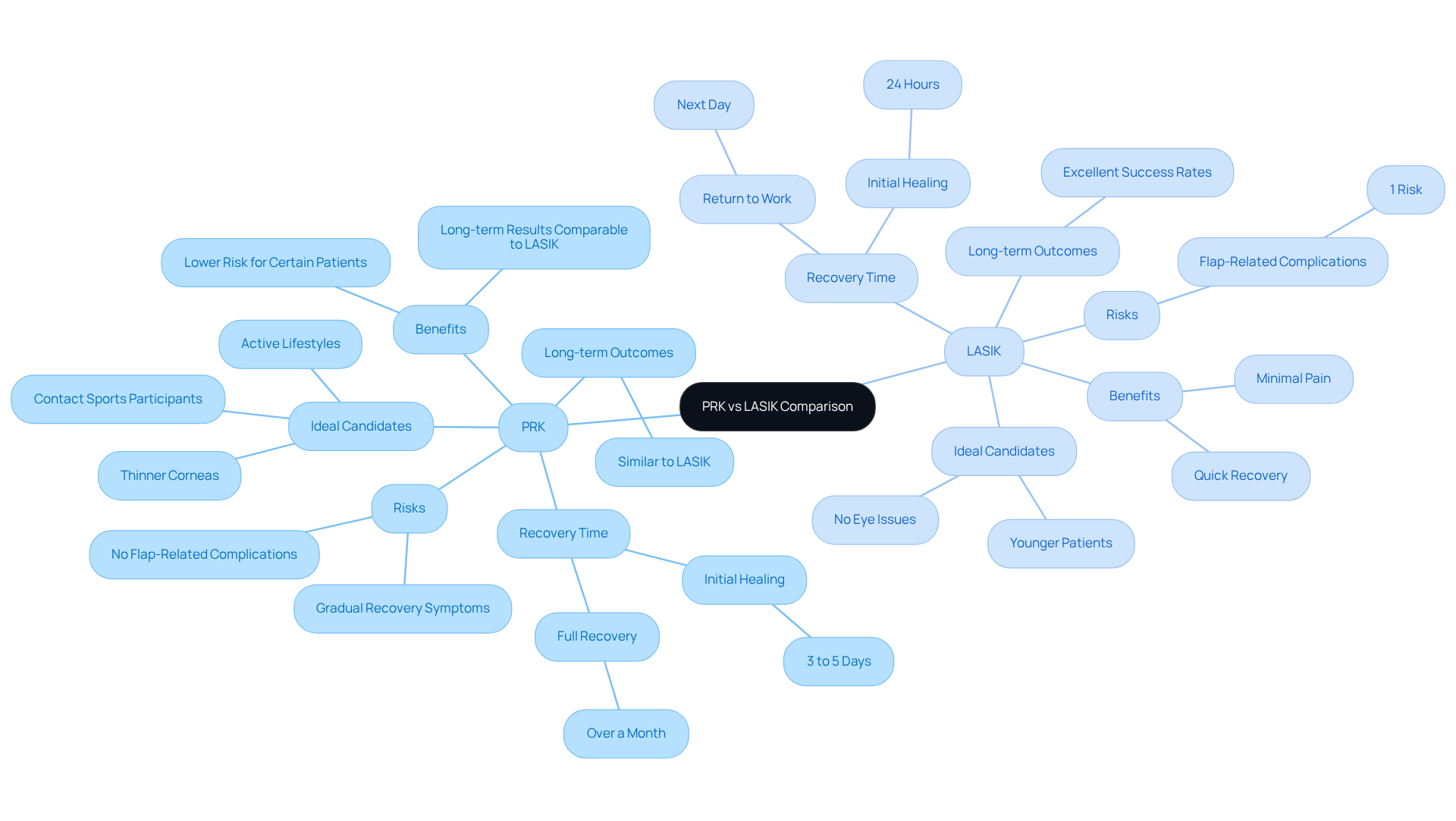
Conclusion
When evaluating the differences between PRK and LASIK, we understand that this decision can feel overwhelming. Both procedures offer effective solutions for vision correction, yet they cater to distinct needs and circumstances. By recognizing the unique characteristics of each method—including surgical techniques, recovery times, candidacy requirements, and potential risks—you can make informed decisions that align with your personal health and lifestyle.
Key arguments highlighted throughout our discussion emphasize the advantages of LASIK’s swift recovery and immediate visual improvements. In contrast, PRK is particularly suitable for those with thinner corneas or active lifestyles. It’s common to feel uncertain about which option is best. While LASIK may provide quicker results, PRK maintains comparable long-term effectiveness and is often more affordable. Ultimately, the choice between PRK and LASIK should be guided by a thorough evaluation of your eye health and personal preferences.
Reflecting on these insights underscores the importance of consulting with experienced professionals, such as those at Northwest Eye, who can provide tailored guidance and support throughout your decision-making process. As vision correction technology continues to advance, prioritizing informed choices and understanding the nuances of each procedure will empower you to achieve optimal visual health and enhance your quality of life. We are here to help you through this process, ensuring you feel confident in your choices.
Frequently Asked Questions
What is Northwest Eye known for?
Northwest Eye is renowned for its expert LASIK procedures and advanced technology in vision correction, prioritizing patient comfort and knowledge through comprehensive consultations.
What types of LASIK procedures does Northwest Eye offer?
Northwest Eye offers wavefront-guided and topography-guided LASIK procedures, which are tailored to individual patient requirements for accurate and efficient treatments.
What do patient testimonials indicate about LASIK outcomes at Northwest Eye?
An impressive 98% of vision correction patients at Northwest Eye report an enhanced quality of life and a decreased reliance on corrective lenses.
What is the difference between PRK and LASIK?
LASIK involves creating a thin flap in the cornea for reshaping underlying tissue, leading to quick visual improvement, while PRK entails the complete removal of the cornea’s outer layer, which regenerates over several days.
How long does PRK surgery take and what is the recovery like?
PRK surgery typically takes about 15 minutes for both eyes. Recovery involves sore or scratchy eyes for a few days, with halos around lights at night, and optimal vision recovery can take 1 to 4 weeks.
Who might benefit more from PRK over LASIK?
PRK may be particularly beneficial for individuals with thinner corneas or those engaged in contact sports, as it eliminates the risk of flap-related complications associated with LASIK.
What are the typical costs associated with laser eye surgery?
The cost of laser eye surgery typically hovers around $2,200 for each eye, with PRK often being several hundred dollars cheaper than LASIK.
How do recovery times differ between PRK and LASIK?
LASIK patients can usually resume normal activities within 24 to 48 hours, while PRK patients may take 4 to 7 days for initial healing, with gradual vision improvement over several weeks.
What should patients expect in terms of discomfort after PRK?
PRK patients may experience moderate discomfort similar to a mild sunburn, particularly during the first few days post-surgery, which is manageable with prescribed pain relief.
What resources does Northwest Eye provide to help patients understand their conditions?
Northwest Eye offers resources like the Eye Condition Library to empower patients to better understand their conditions and treatment options.






